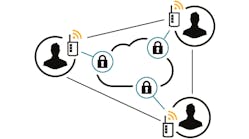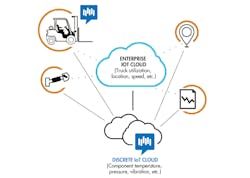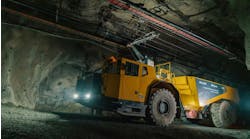Download this article as a .PDF
Without a doubt, the biggest news in manufacturing for the decade is the rapid proliferation of low-cost sensing and computer processing being attached to all types of industrial equipment—everything from connectors, hose and tubing to pumps, motors, actuators and filters. In fluid power systems, the line between actuator and sensor is becoming increasingly blurred.
Traditionally, solenoid-operated valves were powered by simple contactors in an output card; today, more of them are on the network and have built-in diagnostic sensing to monitor temperature, voltage, current, and even cycle counts. The massive amount of data these sensors produce creates an equally massive opportunity to transform the way factory managers operate and maintain industrial equipment.
IoT or IIoT?
However, those opportunities have largely remained unexploited. Although Internet of Things (IoT) technology has largely focused on enterprise-level IoT systems, these systems aren’t yet able to collect data from the component level. To borrow from the language of telecommunications, industrial IoT hasn’t yet made the “last mile” connection to the individual components of machines, reducing its overall value.
Some important differences exist between IoT and IIoT. The initial I stands for Industrial, and means principles of IoT are applied in a factory setting. The architecture and connectivity to the cloud will vary from industry to industry and customer to customer. The overriding principles that should prevail are:
- Starting with an understanding of what specific business or operational goals are desired with an IoT architecture (be that a reduction in downtime, increase of production speeds, leveraging predictive analytics, etc.).
- Procuring intelligent components that are able to connect to the desired architecture
- Partnering with a reliable manufacturer that has proven the capability to own the IoT architecture and facilitate the attainment of the initial desired goals.
What About Security?
Security concerns, proprietary protocols, and the enormous mass of data that would be generated have all discouraged operators from making the final connection from components to the IIoT and gaining the insights they need to predict failures and optimize performance at the machine component level. But that may change sooner than anyone thinks.
For those looking for guidance on how to move forward, this is the point where choosing the right vendor is of the essence. It’s critical to choose suppliers who can share technical knowledge and hands-on experience gained from working across a wide range of applications. At Parker, our experience with thousands of applications across multiple industries has been invaluable in addressing the challenges of discrete IoT effectively.
For example, our experience in fluid power has helped guide us to where sensors should be integrated to obtain optimal insights, the type of data to collect, and how to present the results to maintenance, repair, and operations professionals in the way that is most useful to them.
IIoT in Practice
Embedded sensors could be located on many different low-level fluid power products in an IIoT implementation. For example, some of the diagnostic data generated from control valves could be invaluable in troubleshooting power issues. One common concern is voltage sags downstream on long runs, which will sometimes lead to valve misfires. Normally, there would be no way of diagnosing the cause of the problem unless an oscilloscope happened to be plugged in and monitored the voltage signal when a sag occurred. However, if each valve manifold node included voltage sensing, a “sweeper” program could be written to record voltage levels across the machine during certain periods of the cycle.
IIoT technology would be invaluable in predicting hydraulic hose or connector leakage. With vibration sensors embedded at the right locations on a hose or connector and the tools to communicate that data back to a monitoring system, it would be simple to write a program to conduct and record a simple trend analysis to predict if a hydraulic leak was likely to occur.
Similar implementations could be employed for detecting leaking piston seals in a hydraulic actuator. With the right embedded temperature sensor, a cylinder could alert maintenance personnel to an unexpected temperature differential, which might indicate bypassing of the piston seal.
But applications experience alone isn’t sufficient to span the last mile. Addressing the challenges of discrete IoT also requires focus and commitment. Several years ago, Parker initiated a centralized strategy to ensure the IoT-empowered products and subsystems then under development across our businesses would share the same communications standards and best practices to provide greater interoperability and security. Fortunately enough, pneumatics has led the fluid power technologies in the adoption of communications standards such as Ethernet/IP, EtherCAT, and PROFINET, the world’s most advanced Industrial Ethernet solution for networking production assets like actuators, sensors, sub-systems and production units and equipment such as DCS, PLCs, and enterprise-wide IT systems. IO‑Link is the first I/O technology for communicating with sensors and actuators to be adopted as an international standard (IEC 61131-9). This new open communication technology is bringing the IIoT world to the component level. It’s this type of open communication that will be essential to ensuring interoperability across multiple technologies and manufacturers.
Component manufacturers’ products must work in cooperation with products from other manufacturers. In fact, the value of any IoT solution is directly proportional to its interoperability. There’s no place for proprietary solutions; an open, exchange-based architecture that enables interoperability with third-party products, applications and platforms is essential. The OPC Foundation and the Industrial Internet Consortium are two important organizations working to advance interoperability across IoT devices and platforms.
For virtually everyone considering investing in IIoT technology, concerns about data security and ease of use are paramount. At Parker, we’re striving to bake in best-practice data encryption in motion and storage to create an end-to-end secure ecosystem. We’re also employing a common visualization scheme to ensure a consistent experience from one solution to another. The outcome is an open, secure, interoperable and scalable ecosystem of connected products and services designed to improve industrial productivity by bridging the last mile of IIoT. We call that evolving ecosystem the Voice of the Machine.




